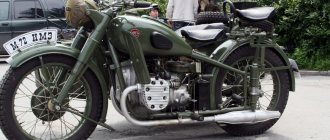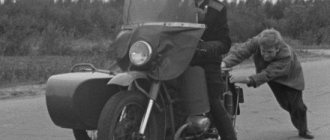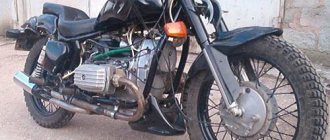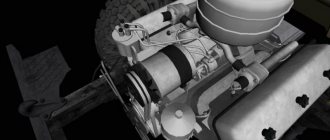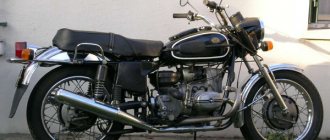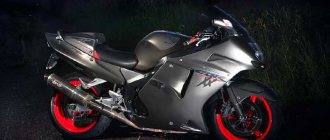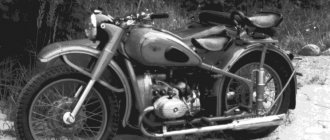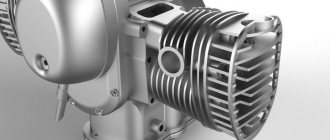Dnepr VS Ural
When choosing a motorcycle, many look towards domestic production.
Today I will tell you about the Dnepr and Ural motorcycles.
How are they different?
And how are they similar?
"Ural"
- Soviet and Russian heavy motorcycle, produced at the Irbit motorcycle plant (Sverdlovsk region, Irbit). In the vast majority of cases it is used with a stroller. Motorcycle models are available both with and without sidecar wheel drive.
Dnieper
- a heavy road motorcycle with a sidecar, produced by KMZ - Kyiv Motorcycle Plant.
Let's start with the similarities
- Both motorcycles began to be produced according to the model of the German BMW R-71.
2. Some parts are interchangeable. For example, electronics, crankcases.
3. Bulky, huge weight.
4. The principle of operation of motors.
5. They consume a lot of fuel.
6. Excellent cross-country ability.
And now the differences
- The Ural motorcycle has a more sophisticated oil purification system. It contains an oil filter.
- In the Dnieper, the function of oil purification is performed by a centrifuge, which operates only at high speeds.
- The Dnepr motorcycle has a more comfortable gearbox,
- possessing a semi-automatic machine.
- The Ural crankshaft is composite.
- The Dnepr crankshaft is solid.
- Dnepr has an oil pressure warning light.
- Different cylinder designs.
- Ural is more reliable.
- The Dnieper is more capricious.
- There are many more high-quality parts for the Ural motorcycle.
- The Dnepr has mostly Chinese low-quality spare parts.
- Different cardan mechanism.
- The Dnepr is equipped with a four-stroke opposed two-cylinder engine with a volume of 650 cm³ and a power of 32 hp.
- The Ural is equipped with a four-stroke opposed two-cylinder engine with a volume of 750 cm³ and a power of 41 hp.
The Ural motorcycle is more powerful and reliable. Easier to find quality parts.
The Dnepr motorcycle is less powerful and more capricious. There are few high-quality parts, mostly all spare parts are made in China.
Source
Differences between the Dnieper and the Urals motorcycle
The main disadvantage of MT, which the relatively latest IMZ products do not have, is the flaw in the engine lubrication system.
KMZ bikes often have problems with oil pressure. However, there is an indicator light on the panel that will notify the driver of such troubles. The oil purification system in Dnepr still does not effectively remove debris due to the lack of an oil filter. The functions of the latter are performed by a centrifuge, which works reliably and efficiently only at high speeds of the bike. Any failure to notice in a timely manner in the functioning of the lubrication system can inevitably lead to injury to various parts of the engine. But with the air filter, Kyiv MT is doing much better. This makes the Dnepr better than the Urals, as well as the comfort of using the gearbox. All Dnieper (from the 9th to the 16th model from KMZ) have a very convenient mechanism for interacting with the checkpoint. Just look at the presence of a reverse gear (which these days, if desired, can be converted to fifth gear according to ready-made drawings or to order in certain offices) and the absence of the need to squeeze the clutch handle when changing between gears (the so-called semi-automatic).
Let's check which Soviet motorcycle had a more reliable and better engine, the Dnieper or the Urals
Motorcycles are popular not only in our country, but throughout the world; fans of this type of transport know this firsthand. They also came to our country from abroad, the first heavy motorcycles, for example, appeared only after 1947, then motorcycle production began to develop, and by the 70-80s we already had a decent motorcycle fleet, consisting of different classes of motorcycles. The most valuable then were motorcycles with a sidecar; the motorcycle replaced the car at that moment; only decades later did motorcycles begin to fade into the background and the car became more accessible and a priority for people. Any equipment, including household equipment, works with the help of an engine, of course it is different everywhere, today we will try to understand which engine of two Soviet motorcycles was better and more reliable, the Dnepr or the Ural motorcycle. Both of these heavy motorcycles have a whole line of their products, Dnepr had 8 models, and Ural had 6.
Let's start with the Dnepr engine; in all its modifications, the working volume was from 650 to 750 cubic centimeters. The engine was a four-stroke with two cylinders, the engine ran on gasoline and consumed about 9 liters per 100 kilometers traveled. Engine power also differed between models, it started from 26 hp. and reached 36 hp. Before a major overhaul, the engine can travel about 25-30 thousand kilometers. The engine has poor ignition, causing the engine to run intermittently. What was installed on Ural motorcycles? The same two-cylinder and four-stroke unit, which consumed an average of 8 liters of fuel.
The engine capacity of all motorcycles was 650 cubic centimeters, but the power varied, starting from 26 hp. and ended at 36 hp, i.e. just like the Dnieper. The service life of the engine before major repairs is 20-25 thousand kilometers. The weak point of the engine can be considered the cylinder heads, which often overheated, as well as the carburetor, which simply spat out half of the fuel supplied to it. Both brands of motorcycles can still be found in personal use, but most likely somewhere in the countryside. It is impossible to say for sure that one engine is better or worse than another; they both have disadvantages that affect the operation of the motorcycle.
If you know any other positive or negative aspects of these two engines, tell us about them in the comments below the article.
If you liked the article, subscribe to the channel and like it
.
Source
What the Dnieper and the Urals have in common (IMZ)
If you don’t take the latest models of motorcycles from the Irbit plant, the above-mentioned steel horses are united by bulkiness, enormous weight, weak aesthetic advantages of the design, and much, much more.
Take the engine, for example. The operating principle of the motors of these boxer engines is the same, as is its structure. With the exception of a small number of components, the engines of the bikes are almost the same. Both MT and Ural can be considered the most reliable Soviet motorcycles. Almost no country in the world produces these heavy units these days. Therefore, in the West there is still a demand for such equipment. Both KMZ and IMZ have created motorcycles that consume a lot of fuel. Both bikes are significantly behind our time in technical equipment with a variety of systems, from an automatic starter to traction control and ABS systems.
What is the difference between the Ural motorcycle and the Dnepr, which is better?
Good afternoon, dear readers. I think many owners of Soviet opposition vehicles have discussed this issue, argued which is better, etc. In this article I will answer this question as objectively as possible, so if I am missing something, write in the comments, then I will add it to the article. To avoid confusion, we will compare the classic Ural and Dnepr with overhead valve engines. Let it be Dnepr MT-11 and Ural 8.103.10.
So. These motorcycles have a common ancestor, and the model range is similar. Let's start from the largest to the smallest.
1) Manufacturer. Ural motorcycles were produced, are being produced, and most likely will be produced in Irbit, on the territory of Russia. If we go deeper into history, the plant moved several times to different cities, but this is not so important. The Kiev Dnieper was produced on the territory of the former Ukrainian SSR, and later simply in Ukraine. At the moment there is no production of Dnepr motorcycles there. Not so long ago it was still possible to buy leftover components from these motorcycles there, and perhaps this opportunity still exists today.
2) Appearance. There are people who confuse them, if your knowledge is not deep in this area, then everything is simple. The fenders on the Dnepr have a more rounded profile, the tank of the Dnepr is more angular, while the Ural has a more classic, teardrop-shaped appearance. The valve covers are also striking; on the Dnieper they are angular, resembling a rectangle, on the Urals the corners are smoothed, generally similar to an oval. The Ural frame has more right angles. The wheel hubs of the Urals are steel, stamped, have a “daisy-like” appearance, and the spokes are of different lengths due to their design, but on the Dnieper the hubs are made of a lighter alloy and are simply round in shape. The instrument panel on the Dnepr is larger, placed on a separate panel, while in the Urals it is made “monolithically” with a headlight, most often it has 4 light bulbs, in older versions there are 2. On the Dnepr there are 5 light bulbs, due to the pressure indicator. Also in the Urals there are more often Lapukha seats, while on the Dnieper there is a monolithic seat. These are the main points, the rest is either faintly noticeable or similar. The side trailers on motorcycles are also almost identical and interchangeable.
3) Technical part. Definitely different engines
, although of the same cubic capacity, general construction architecture, etc. The most important thing is, of course, the design of the crankshaft.
The Urals have a composite crankshaft, i.e. pressed from separate parts, initially positioned as not dismountable, the bearings of the lower head of the connecting rod are roller.
PROS
This design is relatively survivable in case of lubrication system malfunctions and undemanding to oil pressure.
MINUSES
- lower strength (there are known cases of turning at the press joints) and the fact that it is practically impossible to repair (theoretically it is possible to unpress and reassemble, but it is impractical due to the high labor intensity and complexity.
But on the Dnieper, the crankshaft is cast, monolithic, the bearings of the lower heads of the connecting rods are on liners (sleeve bearings), the connecting rods are split - like those of automobile engines.
PROS
: Liners should theoretically last longer and be able to withstand greater loads due to the larger contact area with the shaft compared to rollers. The design is completely repairable - by analogy with automobile crankshafts. This allows you to avoid expensive crankshaft replacement during repairs, as is the case with the Ural.
MINUSES
- if there are interruptions in the supply of lubricant under pressure, the liners will die very quickly. Those. Close monitoring of oil level and pressure is necessary
Based on this, Dnepr has a more complex lubrication system, it requires finer oil purification and stable pressure, this is the credo of Dnepr, namely what repels and scares buyers. If the lubrication system is not properly maintained, the pressure may “float” at low speeds, or even be constantly low. On the Dnieper there is a centrifuge for oil purification, but to clean it, you need to partially disassemble the engine, a small thing, but in the Urals there is an ordinary paper filter, unscrew the old one, install a new one, no washing of the centrifuge. Accordingly, on the Dnieper you can see the oil pressure sensor on the right. Also slightly different crankcase shapes, piston shapes, etc. In the grand scheme of things, this is again insignificant. Different gearboxes, with different gear ratios. Various air boxes.
Checkpoints are also different. The Dnepr box is a little longer, the designs of the air filters are also different: on the Dnieper it is paper, in the Urals it is oil. And most importantly, all Dnepr gearboxes have reverse gear, while the Uralov ones have it only on early modifications, and even then quite rarely. The gear ratios of the Dnepr gearbox are also different, the 4th gear of the Dnepr is slightly longer, so it is logical to install this gearbox if you need to increase the speed. Dnepr gearboxes are also distinguished by a longer gearbox foot travel and smoother shifting.
Ural and Dnieper - what are the differences and similarities
All village residents dreamed of riding a motorcycle in childhood, and of buying this vehicle as an adult.
Many people begin to get acquainted with two-wheeled equipment in early childhood, when they get on a bicycle. At first he has a three-wheeler, then, when the habit and some skills appear, the parents put him on a two-wheeler. As teenagers, everyone asked their parents for small mopeds, hoping that when they were older they would ride a motorcycle. They seemed to be almost identical motorcycles, which at that time satisfied the needs of many citizens. If earlier owners fought for the title of the best motorcycle, today that time has passed. Both brands are remembered and honored, especially by the older generation.
Select it and press Ctrl + Enter
IMHO the Urals will be better than the Dnieper. I had experience with both, but I didn’t like the handling in the Dnieper.
Dibil. What kind of fuel with oil? Clean gasoline was poured
The author made a mistake - pure gasoline without oil was poured into the gas tanks of both URAL and Dnieper. Both have four-stroke engines!
The author apparently had nothing but a moped, gasoline and oil!
The author should be beaten with gimbals for such an article.
@YIMufa, well done! Everything is to the point, I drove them myself since I was 10 years old, dismantled the engines, changed the liners, etc. and so on. I forgot to mention the rear speed of the Dnieper, and in the Urals there was a drive to the sidecar wheel.
@YIMufa, I agree. What does the article by a person far from these motorcycles say, MT-10-36? Isn't it the power of the engine? Consumption was adjusted to suit power. And where is the difference in gearboxes, the Dnepr has a long shift stroke plus a semi-automatic gearbox, the gears were switched without pressing the clutch on the steering wheel, the Ural on a “dry” gearbox has a short pedal stroke with a characteristic loud click, plus there was no reverse gear, and on the right the lever on the box is only for setting neutral, and the Ural had one exhaust pipe. Subsequently, they made a reverse gear and two pipes. Plus, the high-speed engine of the Urals was inferior to the Dnieper for crawling through arable land, when you engage the gear, and you walk alongside, supporting it with gas. The low-slung Ural liked its stability on slopes and tipped over less often. And why are there photos of different models of motorcycles? I would also like to tell you about the MT-11 with a leading sidecar. But the Ural continues to be produced, the author goes to the plant’s website, although the prices are comparable to cars. I went to school alone in a “heavy” one, the rest preferred Java, ChZty, and our Izhi, one rode in Pannonia (who remembers there were such ones), took 6 people up a mountain with a canopy, pulled it out. And then no one in our town counted gasoline, 3 liters. bring homemade wine to the military fleet and take away as much gasoline as you can. We bought the Dnepr after standing in line for 2 years through Voentorg in Chisinau for 1,100 rubles, a 200 km haul, but a defect was discovered in the engine, we had to remove it and send it to the factory for exchange, after 1.5 months a new one arrived. And the Ural, which I drove for a year, was the neighbor’s while he was in Afghanistan. Don’t ask a schoolboy about his license, not a single traffic cop stopped him in all that time, and they weren’t asked at the technical inspection. I liked the Dnepr, carburetor settings, synchronization between engines, valves, any schoolchild could handle it. The only thing is that the “lambs” on the exhaust pipes are large, at the most inopportune moment early in the morning they broke off against an obstacle and the roar of the engine without mufflers said that it was me who was driving.
Source
History of "Dnepr"
The first motorcycle under the Dnepr brand was released back in 1950. The last one from the “Chopper” series rolled off the assembly line in 1992. In 2000, they tried to revive production; a special modification of the motorcycle was created, which was supposed to be exported, but in the end less than three dozen such models were produced, which were later transferred to the Ukrainian motorized regiment, and the project was canceled. Now the plant is being converted into a business center, the equipment is being handed over to a scrap metal collection point, we can say that an attempt at another revival will not take place with almost a hundred percent probability.
Characteristics of "Dnepr"
Over the years of production, modifications of motorcycles have changed. In the first models, the engine had a power of 22 horsepower, and the most powerful model over the years of production produced 36 horsepower. The motorcycles had an internal combustion engine with two opposed-type cylinders (four-stroke).
Motorcycle engines consumed 7-10 liters of fuel per hundred kilometers, depending on the speed of movement and driving style. The maximum speed stated in the passport was 105 km/h. The length of the motorcycle is 2.43 meters, its width together with the passenger sidecar is 1.5 meters, the height of the vehicle from the road surface is 1.1 meters.
Specifications
The Dnepr and Ural motorcycles were produced in several modifications - Dnepr -11; 12 and 16. Larger Urals: M62; 63; 66; 67; 67-36 and IMZ-8.103.
- The length of the Dnieper is 2420-2430 , the Urals - 2420 - 2490 .
- Width – Dnieper 1500 cm , Ural – 1650 cm .
- The height of the Dnieper and the Urals is 1100 cm .
- The speed is 95 – 105 km/h for both types.
- Weight: Dnepr - 330-355 kg ; Ural - 310-340 kg .
- Fuel consumption per 100 km. ways: Dnieper – 8, 7, 9 liters; Ural - 5.8; 6; 8 liters.
- All of them are four-stroke, carburetor, two-cylinder, air-cooled.
- Engine displacement: Dnepr – 650, 750 m3; Ural - 650 cm3.
- Power: Dnepr – 26; 32 hp ; Ural - 28-36 hp .
- Both have an oil-based air cleaner with two-stage cleaning.
- The gearbox is four-speed.
- Battery: 6-12v.
- Brakes: mechanical, shoe with friction linings.
- Fuel tank: 19-22 liters .
- Oil capacity in the engine crankcase is 2.0 - 2.3 liters.
- Gearboxes - 0.8 - 1.5 l .
- Air cleaner – 0.125 – 2.0 l .
- The frame is tubular.
- Front: telescopic fork with double-acting hydraulic shock absorbers.
- Rear suspension: initially spring, and then, after modification, lever suspension with double-acting spring-hydraulic shock absorbers.
- Clutch: dry double-disc, driven discs with linings on both sides.
- Reverse gear is available on both types of motorcycles. This is what unites them.
History of "Ural"
This is the only heavy motorcycle that was assembled on the territory of modern Russia (Sverdlovsk region, the city of Irbit). Production began in 1940 (motorcycles were produced that copied similar heavy models from BMW). Later, their own models appeared. Currently, the plant exists and operates, it produces modern models of heavy motorcycles, the main market for the sale of this equipment is the USA.
Characteristics of "Ural"
The classic Ural had an internal combustion engine with two opposed-type cylinders (four-stroke engine). Power was 41 horsepower. This engine consumed about 8-10 liters of gasoline per 100 kilometers. The maximum speed of the motorcycle is 150 km/h according to various data, which are based on reviews of motorcyclists.
The first Ural models had a length of 2.13 meters, the width of the motorcycle with a sidecar was 1.59 meters, and the height from the road was one meter. More modern models have become a little larger, but these increases in size are minimal.
If we talk today about which is better, “Dnepr” or “Ural”, then the best model will be the one from the city of Irbit, because the Ukrainian competitor simply no longer exists. This makes me a little sad, but it's a fact. Now let's start comparing the older models of these motorcycles. So, “Dnepr” or “Ural”? Which of these options is better?
Reliability
In many ways, the design of these motorcycles was very similar, but there were differences. The main one is the design of the crankshaft. On the Ural it was composite (assembled by pressing), non-separable, with roller bearings of the lower head of the connecting rod. This system had advantages:
- The durability of the unit even in case of any malfunction of the lubrication system.
- Relatively undemanding to oil pressure.
But not everything was smooth, there were also disadvantages:
- Relatively low strength (there are cases of the crankshaft turning at the pressing points).
Such a crankshaft cannot be repaired (in theory, you can unpress it, sort it out and reassemble it again, but this is very labor-intensive and expensive; in practice, no one does this). The Dnepr had a solid crankshaft, with plain bearings on the lower connecting rod heads. The connecting rods themselves are collapsible. Strengths of such a system:
- The liners have a long service life; they are able to withstand increased loads, as they have an increased contact area with the shaft.
- The crankshaft is repairable.
Transmission
Why is the Dnepr motorcycle better than the Ural? Objectively the gearbox. The most reliable unit was the Dnepr motorcycle of the MT-804 modification. The gearbox had clear gear shifting and was also particularly smooth. On some versions of the Ural, the gearbox is the owner’s worst nightmare.
Dnepr gearboxes had reverse gear and automatic clutch release when changing gears. The reverse gear on these motorcycles is activated by a special manual lever. It was located on the right in the driver's foot area. Reverse gear could only be engaged from neutral gear. Some craftsmen converted the reverse gear into fifth, according to reviews.
“Urals” with reverse gear also existed, but very often when trying to engage the rear gear, neutral was “caught.” The box had two special bolts for adjusting this moment, but this was of little use.
In general, the gearboxes on these two motorcycles are interchangeable, but they are slightly different in length. So, we found out which is better, “Dnepr” or “Ural”, in terms of checkpoints. Victory for Dnepr.
There are still many differences between the Urals and MT
It is important to understand that a motorcycle has its own special mission for each person/driver.
Depending on this, you should choose between these opposing players, without fear of making a significant mistake. Both bikes come from the USSR and have a common ancestor from Nazi Germany, which the Germans kindly shared with us, without even wanting it. There are more operational problems with the Dnieper from KMZ (problems of care and control) than with the Urals from IMZ, but the former is still more powerful. It not only has a large number of horses, but also has better agility. And also the mobility that comes from having a bike with a boxer engine and a reverse gear. Another thing that will please you is that the Kiev motorcycle is often equipped with a sidecar with direct drive. With IMZ everything is more neglected. Only rare models of this motorcycle received such a charm.
The structural differences between the Dnepr and Ural motorcycles affect many components and spare parts of the iron horses. The type of spoke arrangement, the lubrication system, the cardan mechanism, the shape of the crankcase, the features of the crankshafts, the method of mounting the cylinders and the shape of the cylinder heads are not all the differences in these bikes. Still, there are fewer of them than similarities.
Motor
Which engine is better - Ural or Dnepr? Over the years of production of both motorcycles, the engines have been changed and improved, but no modification of either of these motorcycles can be called extremely reliable and problem-free.
Of course, there were some specimens that could not break for decades, but this was more likely a matter of luck rather than a pattern. Let's say that it is easier and cheaper to find spare parts and components for the Ural engine in our time, so it wins in this matter.
Which is better, “Ural” or “Dnepr”: reviews
There is something special here. Motorcycle enthusiasts are divided into camps. Some people adore the Ural, others are crazy about the Dnepr. But we tried to select some objective grains from the mountain of emotions and tried to find out which is better, “Dnepr” or “Ural”. Owner reviews are positive and negative for both participants in this duel.
Opinions say that the Ural is faster, but at the same time the Dnepr is a more high-torque motorcycle. The owners of both of these competitors say that any device can be brought to a condition close to excellent, the only thing is that for this you will need a lot of money and time. Of course, everything is relative, you don’t need to think that spare parts cost a lot of money. No, but sometimes buying a motorcycle is cheaper than repairing it after a while. This opinion is not taken from heaven, it is obtained from real reviews.
If you have the time and desire, and are also willing to spend some money, then you can safely buy any of these motorcycles. And it’s better, if you believe the reviews, to buy the one you like; to understand this, you need to ride each of the motorcycles behind the wheel.
What to choose
On modern roads, especially in the Russian expanses, you can’t go far in cars. An all-terrain vehicle is not accessible to everyone. All that remains is a scooter or a bicycle. However, there is another effective means of transportation, especially off-road - a motorcycle. The motorcycle is much better, faster and you can attach a stroller. Why not a car? Only without a roof, in the open air.
What brands and countries of manufacturers are there? Yamahas, Harleys, Urals, Bobbers and Choppers, Dnepr, Customs, BMWs and many others. Undoubtedly, each type of such technology has advantages and disadvantages, and this is not bad, there is plenty to choose from and something to compare with. You are offered the two most common domestic types of motorcycles, more affordable on our market and proven to be the best for riding especially off-road: the Ural and the Dnepr . True, during the division of the Soviet state, the Dnepr motorcycle remained in Ukraine.
To sum up
The dispute between Dnepr and Ural is forever. You need to understand that we are talking about quite old equipment, which is already pretty battered by life or the previous owner. In many ways, this debate about which is better will be decided by the condition of the specific specimens. But no one forbids you, for example, to buy a faster Ural and install a reliable box from the Dnepr on it, or come up with some similar option of your own.
Source
